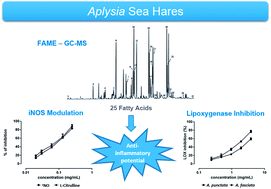Fatty acids from edible sea hares: anti-inflammatory capacity in LPS-stimulated RAW 264.7 cells involves iNOS modulation
Abstract
The inclusion of marine organisms in the diet is gaining importance due to their richness in health beneficial nutrients. This study evaluated the fatty acid composition and anti-inflammatory potential of lipophilic extracts of two edible sea hares, Aplysia fasciata Poiret and Aplysia punctata Cuvier. Twenty-five fatty acids were determined, nine of them not yet reported in these species. They revealed similar anti-inflammatory properties in RAW 264.7 cells stimulated with lipopolysaccharide, as ascertained by the decreased levels of ˙NO in the culture medium. A decrease of L-citrulline was also observed, indicating that the compounds may act by modulation of inducible nitric oxide synthase (iNOS). A. punctata was most effective as lipoxygenase inhibitor, probably because it contains more polyunsaturated fatty acids (PUFA) that can compete with linoleic acid for the active site, decreasing enzyme activity. The anti-inflammatory potential of A. fasciata and A. punctata is reported here for the first time.


 Please wait while we load your content...
Please wait while we load your content...